IDEX Online Research: Polished Diamond Prices Unchanged in October
November 04, 09
Market demand for diamonds during October, as the industry was heading into the all-important Christmas holiday selling season, was enough to keep polished diamond prices in the trading centers from sagging, but it wasn’t strong enough to push diamond prices higher.
Polished diamond prices showed almost no movement during October, the final month for diamond shipments into the U.S. market for Christmas consumption, according to the IDEX Online Polished Diamond Price Index. The Index had its narrowest trading range in months – it moved less than a hundred basis points between the high point and the low point during October – shown as an Index of 108 on the IDEX Online Polished Diamond Price Index.
There was a slight flurry of trading activity just after the middle of the month, and it appeared that prices might move higher. But by the end of the month, polished diamond trading activity settled back to the level of the past several months.
Because of weak demand and sluggish polished diamond trading activity, most of the market requirements are being met from existing gemstone inventories in the diamond trading centers. As a result, polished diamond prices have remained in a very narrow trading range since this Spring – some would say that prices are stuck in a rut – with no immediate sign that the market is headed higher . . . or lower. We note, however, that there have been some signs of price strength in certain larger higher quality size stones. It is not clear if these prices are sustainable, or just the result of internal pricing adjustments within certain trading bourses.
Diamantaires are pinning their hopes on stronger demand in 2010. With the likelihood that the world’s largest diamond market – the U.S. – may experience a slow recovery from the economic funk that has affected diamond demand for two years, diamond traders are focusing their efforts on developing sales in emerging markets such as China. The Chinese New Year is celebrated in February, and it represents an opportunity for consumers in that country to give gifts of jewelry. Further, there are brightened prospects for jewelry demand during the gift-giving season surrounding the Hindi New Year in India, as well as the wedding season post-Diwali.
Even though the U.S. market may not fuel significantly stronger diamond demand in 2010, there are some factors that will contribute to sustained higher demand – primarily the expected increase in the number of weddings. Driven by favorable demographics – a baby boomlet of Millennials born in the 1980s – the number of weddings has continued to rise in America, despite the recessionary environment. However, the average ticket for a diamond engagement ring is down by an estimated 10 percent, about in line with other spending cuts that brides have made in their budgets.
Despite continued weak demand in the U.S. market, IDEX Online Research is forecasting that jewelry sales will rise very modestly during the all-important holiday selling season of November and December. If this forecast materializes, it will be the first positive news from the American market in almost two years. With last year’s sales during the holiday period extremely weak, it is almost a given that sales this year will be stronger. Not only is the American economy on the mend, but recent jewelry sales comparisons have been “less bad.” Jewelry sales won’t return to the levels of the heady days of 2006 and early 2007 – when holiday sales were in the $9.0-9.1 billion range (for all jewelry, about half of which is diamond jewelry) – but they will be better than last year’s disastrous $7.2 billion. We are currently forecasting total jewelry sales for 2009 Christmas selling season of $7.3-7.4 billion. This would generate a positive percentage comparison of +1 percent-2 percent, and it would be a tremendous psychological boost to the industry.
The bottom line is this: diamantaires’ hopes are high, but sustained demand has not materialized yet. Despite pockets of pessimism, IDEX Online Research is certain of one thing: the Recession of 2008-2009 will not derail 50,000 years of humans’ cultural affinity for jewelry, gemstones, and precious metals. The market will rebound.
Diamond Prices Depressed Versus Last Year
The IDEX Online Polished Diamond Price Index peaked thirteen months ago at 128.91 in August 2008 in the current cycle, and it began an eight-month free-fall from there, stabilizing in April 2009. In October 2008, the IDEX Online Index was 127.02. Since the peak in August 2008, polished diamond prices have fallen about 16 percent. Owners of stocks, bonds, and real estate wish they had been as lucky: their investments fell by as much as 50 percent, before bottoming early in 2009.
The graph below illustrates polished diamond prices for the past 24 months.
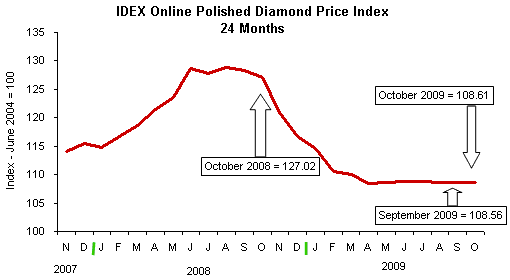
Source: IDEX Online Research
The following table summarizes the IDEX Online Global Polished Price Index since the beginning of 2007.

Source: IDEX Online Research
Month-to-Month Polished Diamond Price Trends:
October 2009 versus September 2009: 0.0%
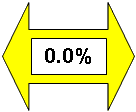 |
In contrast to May when larger diamond sizes showed modest price increases and June when smaller diamond prices crept up, diamond price increases – and decreases – were mixed in October, similar to the past three months. There was one notable price anomaly: the price of four-carat polished diamonds continues to show volatility. The price of these stones jumps one month, only to pull back the following month. In October, demand for four carat diamonds showed modest strength, pushing prices slightly higher, but there were no signs of sustained demand.
On an annualized basis, October’s polished prices indicate no inflation – or deflation – for polished diamonds. There are indications that the economy is firming in some key global markets, so there could be some support for prices. On the other hand, if there are any system shocks, prices could tumble.
We believe history is a great forecaster for the future. If so, the rate of diamond price inflation would be expected rise in early 2010, especially if demand turns out to be stronger than projected. However, we continue to believe that polished diamond price inflation will return to its historic norm of about 3-4 percent annually.
The IDEX Online Polished Diamond Price Index, calculated on the average daily prices during October 2009, stood at 108.61 for the month, roughly flat compared to 108.56 for the month of September 2009. On the last day of October, the IDEX Online Polished Diamond Price Index stood at 108.07, down from the 108.36 level registered on the first day of the month. Unlike earlier months this summer – July in particular – when diamond prices drove the index to just over 109.00 several times during the month, the IDEX Online Polished Price Index never made it outside of the 108 trading range in October, essentially the same trading range as in August and September. The IDEX Online Polished Diamond Price Index stood at 100.00 in July 2004.
The graph below summarizes month-over-month changes in global diamond prices for the past thirteen months. Beginning in February 2008, polished diamond prices showed large gains during every month in the first half of the year. By mid-2008, price increases began moderating. In September 2008, polished diamond prices weakened, showing consistent month-to-month decreases as shown on the graph below, a trend that continued until about April 2009, when prices flattened and began trading in the current range.
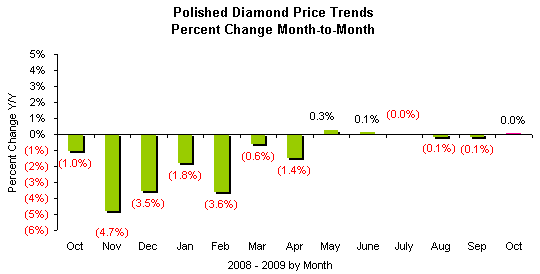
Source: IDEX Online Research
October 2009 versus October 2008: (14.5%)
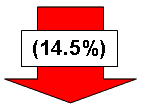 |
All key diamond sizes experienced price deflation in October, with large diamonds – three carat and up – showing greater price deflation than diamonds below three carats in size. This trend – larger diamond prices falling faster – has characterized global polished diamond prices for several months. Prices of those diamonds rose first and fastest in the current cycle; now, they are falling fastest.
Even if diamond prices show a recovery on a month-to-month basis, the year-over-year percentage change will continue to show deflation until late in 2009, when comparisons against 2008 prices become much easier. However, longer term, we continue to predict that polished diamond prices will return to their historical trend line inflation rate of 3-4 percent annually, perhaps in 2010.
The IDEX Online Polished Diamond Price Index averaged 108.61 in October 2009 versus 127.02 in October a year ago.
The graph below summarizes the year-over-year inflation rate by month for polished diamond prices in the global market for the past thirteen months. Comparisons are based on the daily average prices during the month versus the same month a year ago (eg. October 2009 versus October 2008). The year-to-year comparison takes into account the seasonality of polished diamond demand and prices.
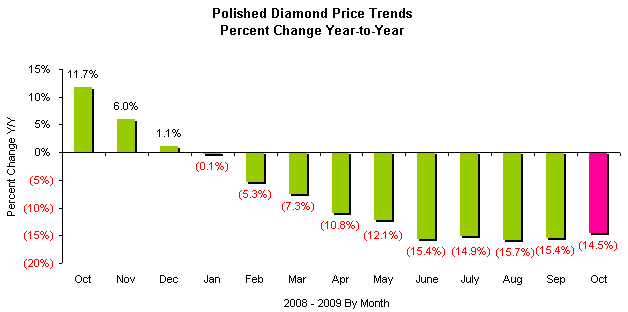
Source: IDEX Online Research
Day-to-Day Diamond Prices Generally Stable
Polished diamond trading patterns in October on a day-to-day basis showed some price fluctuation as traders searched for pockets of demand. However, since this was the final month prior to the holiday selling season, we would have expected to see some improvement in demand, if only for a short period.
The graph below summarizes polished diamond prices on a daily basis for the past three months. Short of some kind of a system shock, we believe that polished diamond prices bottomed in April in the current cycle.
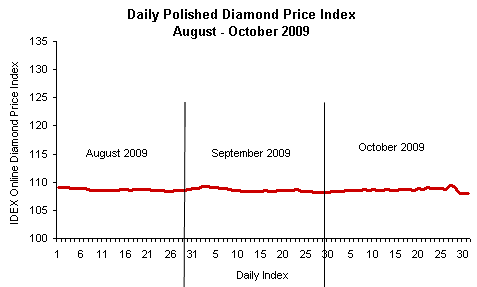
Source: IDEX Online Research
Polished Diamond Price by Size Are Mostly Steady
After rising rapidly in 2008, only to fall just as quickly at the end of the year, diamond prices by key sizes appear to have bottomed. Even more likely, we believe that they are poised to hold steady, and perhaps begin moving higher in early-to-mid 2010.
During October, there were two interesting trends: four-carat diamond prices rose, after falling in September, but rising in August. Meanwhile five-carat diamond prices flattened out, after dipping in August. Apparently, market demand is not sufficient to sustain higher prices of these better-quality, larger diamonds.
The graph below summarizes price trends since late 2006 for the seven key sizes of diamonds; these diamonds represent just under one-third of the total value of the trading market.
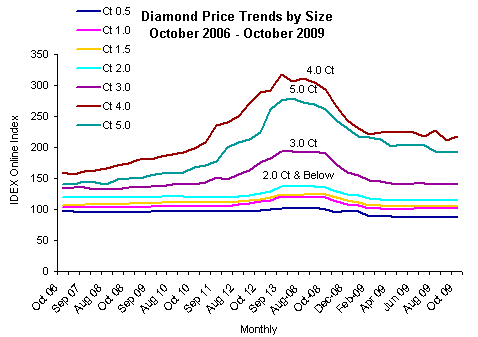
Source: IDEX Online Research
Month-to-Month Diamond Prices Mixed for Key Sizes
During October 2009, month-to-month – October versus September – diamond prices by size were mixed, with some sizes showing a slight price increase while other sizes decreased in price. The sharp increase in four-carat diamonds reflects price volatility which has characterized this size of diamonds over the past several months.
But here’s what is important: prices really didn’t vary much by size on a month-to-month basis.
The graph below summarizes the price changes for key sizes of polished diamonds on a month-over-month basis: October 2009 versus September 2009. These seven stone sizes represent about one-third of the trading market by value.
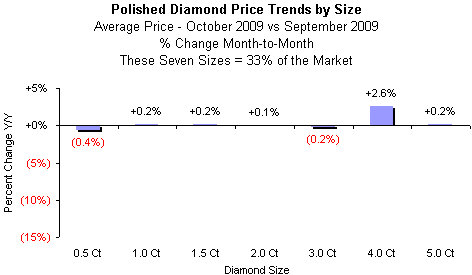
Source: IDEX Online Research
Year-Over-Year Diamond Prices for All Key Sizes Show Deflation
On a year-to-year comparison, polished diamond prices for the key sizes and qualities fell – some significantly – from the prior year. Virtually all sizes of diamonds showed a double-digit loss in price in October, though the overall decline diminished from prior months. Comparisons in October remained difficult, since there were a string of double-digit price gains for the larger diamond sizes in the summer of 2008.
The graph below summarizes polished diamond prices by key sizes on a year-over-year basis: October 2009 versus October 2008. These seven sizes represent about one-third of the market, by aggregate value.
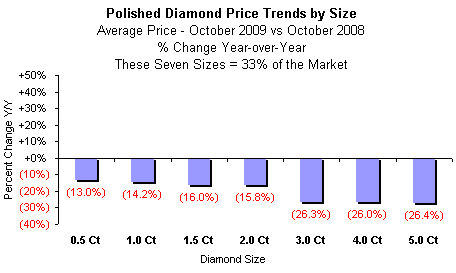
Source: IDEX Online Research
Forecast: Diamond Prices Have Bottomed in Current Cycle
We believe that month-to-month polished diamond prices will likely show flattish or perhaps modestly positive comparisons in subsequent months, especially if demand picks up in developing markets. As a result, year-over-year price comparisons will likely begin to show less disappointing comparisons by the early fall, in our opinion. At some point, probably in late 2010 or early 2011, we believe that diamond price inflation will recover to its historic trend line, reflecting annual inflation of 3-4 percent.
The U.S. market consumes roughly half of the world’s diamond jewelry. Its economy is showing some vitality, after significant weakness over the past year. Further, other regional economies around the globe are also showing some signs of recovery. Along with these recoveries, consumers will resume purchases of luxury goods, though at a pace below historic levels initially.
The IDEX Online Diamond Price Index
The IDEX Online Diamond Price Index is a real-time index derived from actual asking prices in the global diamond industry. The IDEX Online Diamond Price Index objectively reflects price trends as they happen. The Diamond Index and Diamond Drivers were formulated following comprehensive research and analysis of the IDEX Online inventory database, aggregated since 2001. Research and development were conducted in cooperation with Dr. Avi Wohl, Senior Lecturer of Finance at the faculty of Management, Tel Aviv University, Israel.
Additional information is available from IDEX Online Research. The e-mail address is diamondprices [at] idexonline [dot] com.